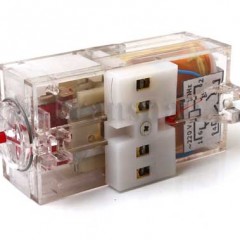Why do I need a load priority relay?
Appointment
The priority relay is used to control groups of consumers in electric networks in which the maximum power consumption is limited and does not allow to include all the necessary consumers of electric energy in the network at the same time.
Also, this device can act as a power limit relay in cases where it is necessary to limit the current flowing through a particular section of the circuit, for example, when adding new electric fuses to a network that has insufficient load capacity.
In both cases, the use of a load priority relay avoids tripping circuit breaker from overload, leaving in operation the most important consumers.
Device
The on-load tap-changer has a built-in current meter and an actuator that switches contacts when the threshold value of the current is reached and with a given time delay. The built-in measuring element can control the current in a certain range, depending on the specific type of device.
As for the maximum current switched by the built-in contacts, it usually has a standard value of 16 A. If you need to switch high currents, contactors are used (magnetic starters) - in this case, the priority relay will only supply a control pulse to the contactor.
For the need to control high currents, there are separate types of devices that allow you to connect external current transformers. On-load tap-changers can be either single-phase or three-phase, and depending on the number of controlled loads, they are divided into single-channel and multi-channel.
Three-phase devices can operate as phase priority relays, switching single-phase loads between phases to prevent large phase non-symmetry or to prevent power failure when one of the phases breaks in the mains.
Operating principle
Let us briefly consider the principle of operation of the load priority relay according to the scheme below.
A circuit breaker for a rated current of 25 A is installed at the input, the actual load of electrical appliances is much higher. In order to avoid overload a two-channel device is installed, which allows you to enable and disable two loads. In this case, the first group of consumers is a priority and is constantly in work. The second and third groups are non-priority and turn off when the set threshold value of the current strength is exceeded - in this case 25 A.At the same time, the third group is lower than the second in priority and during the overload it is disconnected first. If the power consumption has not decreased, then the second group of consumers is switched off and only the first priority group remains in operation. As the load decreases, the priority relay will automatically turn on the second and third consumer groups.
Application area
This device is used in cases where the limit of power consumption, determined for an apartment or private house, does not allow you to use all the necessary electrical appliances at the same time.
The load priority selection relay allows you to comfortably operate all the necessary electrical appliances without feeling any inconvenience. Without the use of this device, it would be necessary to manually turn off currently non-priority electrical appliances or, if there was no limitation of power consumption, the wiring would be completely de-energized if the allowable limit was exceeded. Typically, the power limit is limited by a circuit breaker or power limiter.
The usability of this device is especially noticeable if, prior to its installation, the problem of frequent disconnection of the opening circuit breaker was relevant. A sudden blackout of electrical wiring brings a number of inconveniences, the operation of electrical appliances goes astray, and a circuit breaker that is disconnected due to overload can only be turned on after cooling a tripped thermal release.
On-load tap-changers are also used in enterprises. They allow you to operate equipment and various electrical appliances in a limited power limit, which eliminates the need to increase it. Also, in enterprises, this relay is used if it is necessary to implement energy saving measures. For example, if the limit of consumed electric energy is determined for certain needs, then in order to avoid exceeding it, the device will turn off a certain part of consumers.
We also recommend watching a video on which the principle of the device’s operation is described in detail:
So we examined the purpose, structure and principle of operation of the load priority relay. We hope you now understand how the device works and where it is used!
It will be useful to read:








